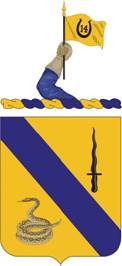The 14th Cavalry Regiment
The 14th Cavalry Regiment is a distinguished cavalry unit within the United States Army. This regiment comprises two squadrons responsible for providing reconnaissance, surveillance, and target acquisition support for Stryker brigade combat teams. Established in 1901, the regiment has participated in numerous conflicts, from the Philippine–American War to Operation Iraqi Freedom and Operation Enduring Freedom in Afghanistan.
History
The roots of the 14th Cavalry trace back to its constitution on February 2, 1901, under War Department General Order Number 14. The regiment officially organized at Fort Leavenworth, Kansas, on March 5, 1901.
Philippines Campaign
From 1903 to 1906, the regiment was stationed in the Philippines, actively involved in insurgency campaigns. After successfully completing this assignment, it returned to the U.S. and took on peacetime garrison duties in the Pacific Northwest. In 1909, the regiment redeployed to the Philippines, primarily performing garrison duties and conducting training.
Mexican Campaign
In 1912, the regiment participated in the Mexican campaign. A detachment of nine troopers guarding Glenn Springs, Texas, faced an attack from approximately 70 Villistas during the Glenn Springs raid on the night of May 5-6, 1916, resulting in the deaths of three privates: William Cohen, Stephen J. Coloe, and Lawrence K. Rogers. Following this, the regiment joined General John J. Pershing‘s expeditionary forces in the Mexican Punitive Expedition against Pancho Villa and his forces in the summer of 1916. The regiment then returned to Texas and patrolled the border until 1918, when it was called for service in Europe. However, the Treaty of Versailles was signed before the regiment could cross the Atlantic, leading them to resume border patrol duties.
Interwar Period
By June 1919, the regiment was stationed at Fort Sam Houston, Texas, later transferring to Fort Ringgold, Texas, on April 30, 1920. Most of the regiment, excluding the 3rd Squadron, moved to Fort Des Moines, Iowa on August 19, 1920. The regiment was assigned to the 2nd Cavalry Division on August 15, 1927, and later assumed control of the Iowa Civilian Conservation Corps District in April 1933 until mid-1934.
World War II
The regiment was inactivated on July 15, 1942, with personnel and equipment reassigned to the newly established 14th Armored Regiment, 9th Armored Division. Reactivation occurred on July 12, 1943, as the 14th Cavalry Group at Fort Lewis, Washington. The group deployed to Europe, landing on Omaha Beach on September 30, 1944, and saw significant action during the Battle of the Bulge.
Cold War
Post-World War II, the group became the 14th Constabulary Regiment and functioned as a police unit until 1948. It was reformed as the 14th Armored Cavalry Regiment and operated on “Freedom’s Frontier” in Germany until its colors were cased in 1972.
2000s
Iraq
The regiment was reactivated on September 15, 2000, as the first reconnaissance, surveillance, and target acquisition unit in a Stryker brigade combat team. During its deployments in Iraq from 2003 to 2006, the 1st Squadron engaged in various operations, focusing on counterinsurgency efforts while fostering cooperation among ethnic groups.
Afghanistan
From December 2011 to December 2012, Task Force 1-14 CAV deployed to Zabul Province, Afghanistan, working alongside local Afghan forces and government entities to strengthen security and governance.
Current Status
- 1st Squadron: Serves as the Reconnaissance, Surveillance and Target Acquisition Squadron of the 1st Brigade Combat Team, 2nd Infantry Division, stationed at Joint Base Lewis-McChord, Washington.
- 2nd Squadron: A Cavalry Squadron of the 2nd Brigade Combat Team, 25th Infantry Division, stationed at Schofield Barracks, Hawaii.
- 4th Squadron: Inactive, previously under the 172nd Brigade Combat Team.
- 5th Squadron: Inactive, reflagged to 2nd Squadron, 14th Cavalry Regiment.
Recent Deployments
- 1st Squadron: Operation Iraqi Freedom (2003–2004, 2006–2007, 2009–2010), Operation Enduring Freedom (2011–2012), Department of Defense Support to Customs & Border Protection (2019).
- 2nd Squadron: Operation Iraqi Freedom (2004–2005, 2007–2009, 2010), Operation New Dawn (2010–2011).
- 4th Squadron: Operation Iraqi Freedom (2005–2006).
Campaign Streamers
The following campaign streamers are flown from the colors of the 14th Cavalry:
- Philippine Insurrection
- Mindanao
- Jolo
- World War II
- Rhineland
- Ardennes-Alsace
- Central Europe
- Leyte
- Ryukyus (with arrowhead)
- Iraq War
- Iraqi Governance
- Iraqi Surge
- Iraqi Sovereignty
Heraldry
The 14th Cavalry Regiment has a distinct coat of arms granted by The Institute of Heraldry:
Description/Blazon:
Shield: Or, a bend Azure between a Moro kris paleways point up Sable, and a rattlesnake coiled to strike Proper.
Crest: On a wreath of the colors Or and Azure, a dexter arm embowed habited Azure, the hand gloved in a buckskin gauntlet Proper, grasping a staff erect Sable barbed Or, thereon a standard flotant of the last charged with a horseshoe heels upward encircling the Arabic numeral ’14’ in Black.
Motto: “Suivez Moi” (Follow Me).
The unit’s coat of arms reflects its history, with the black Moro Kris symbolizing engagements during the Philippine–American War and the coiled rattlesnake representing patrols along the Mexican Border.
In Popular Culture
The 14th Armored Cavalry Regiment was featured in Harold Coyle’s techno-thriller “The Ten Thousand,” published in 1993, where it was part of the U.S. Tenth Army Corps.
See Also
- Observation Post Alpha
References
[References would be inserted here.]

